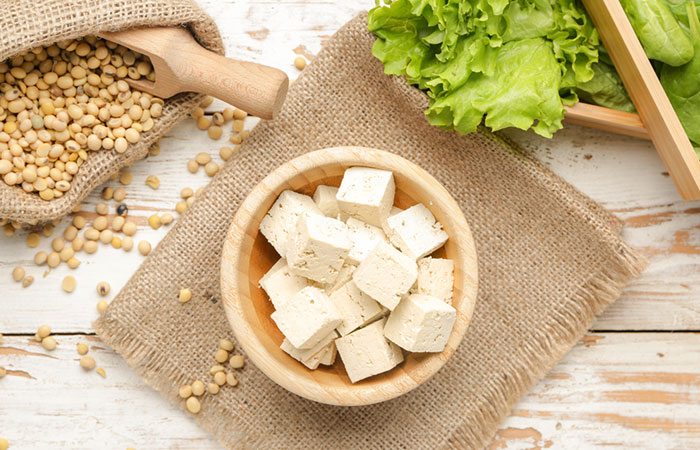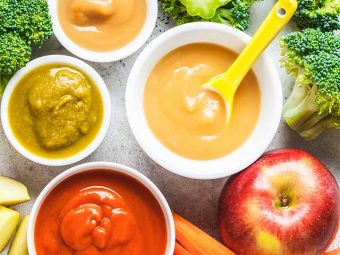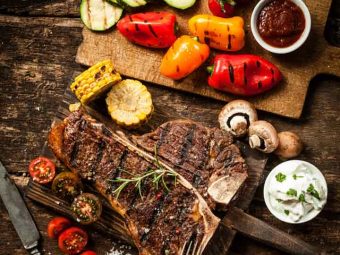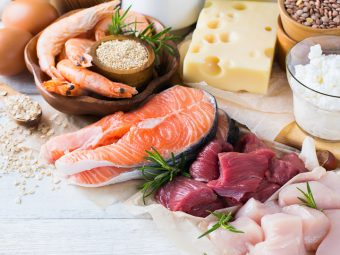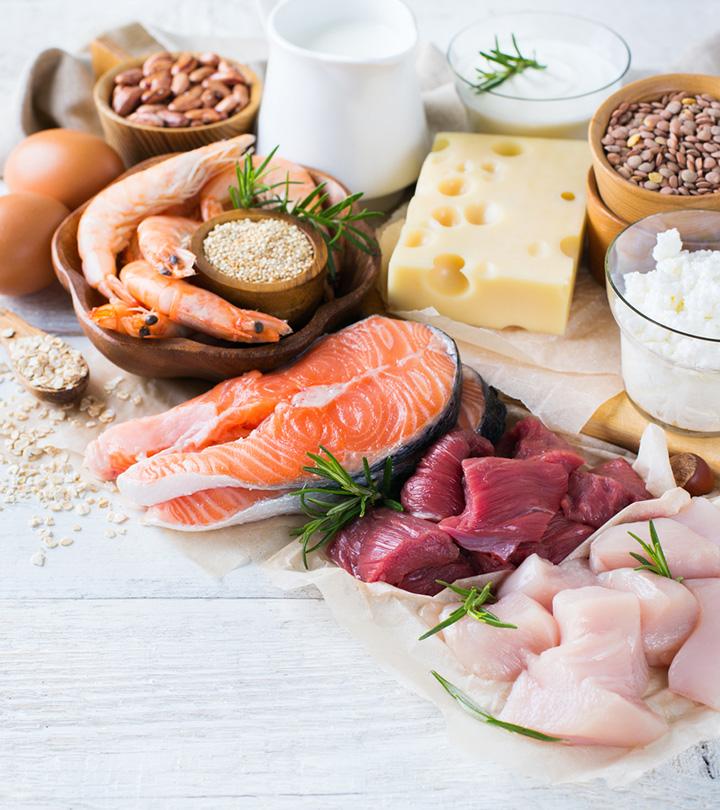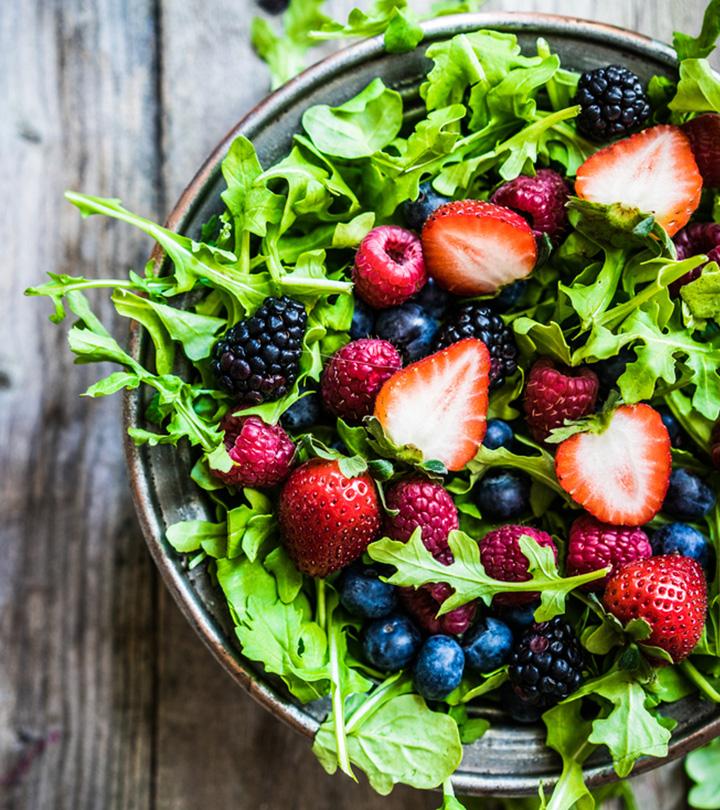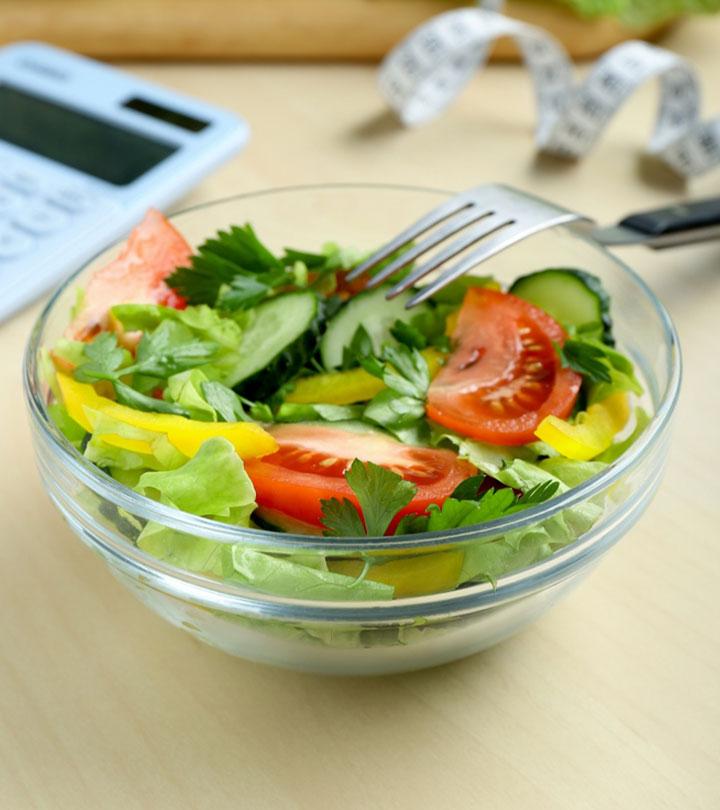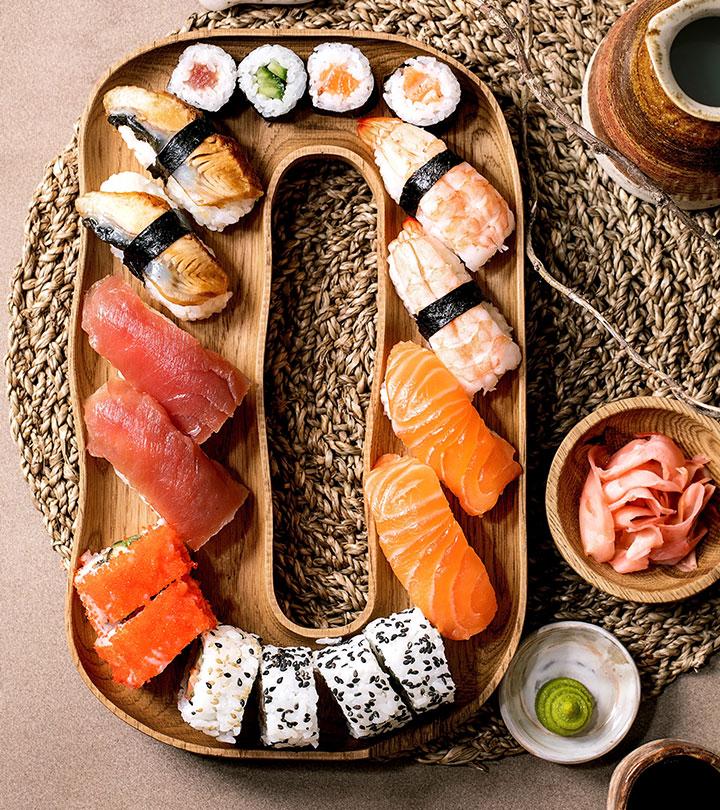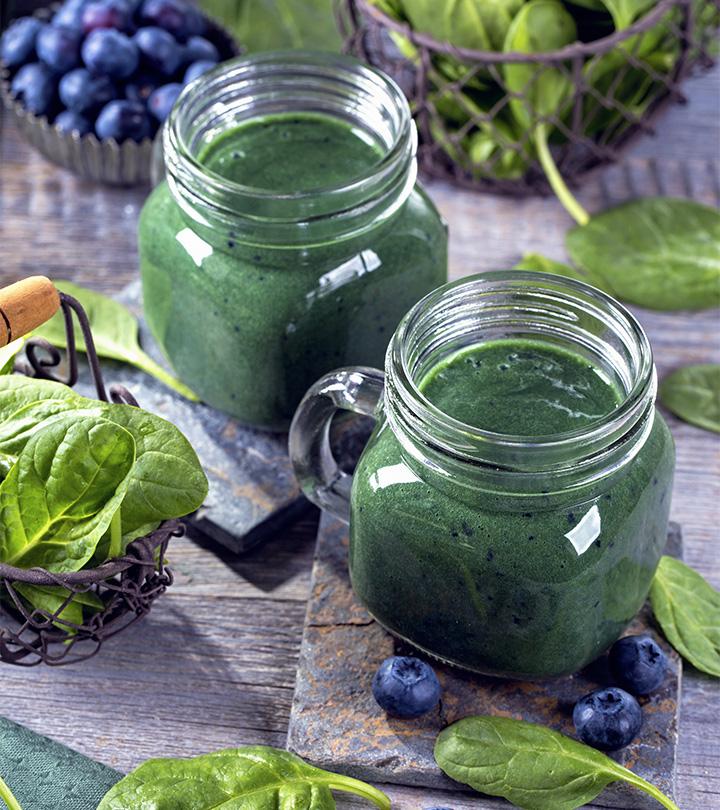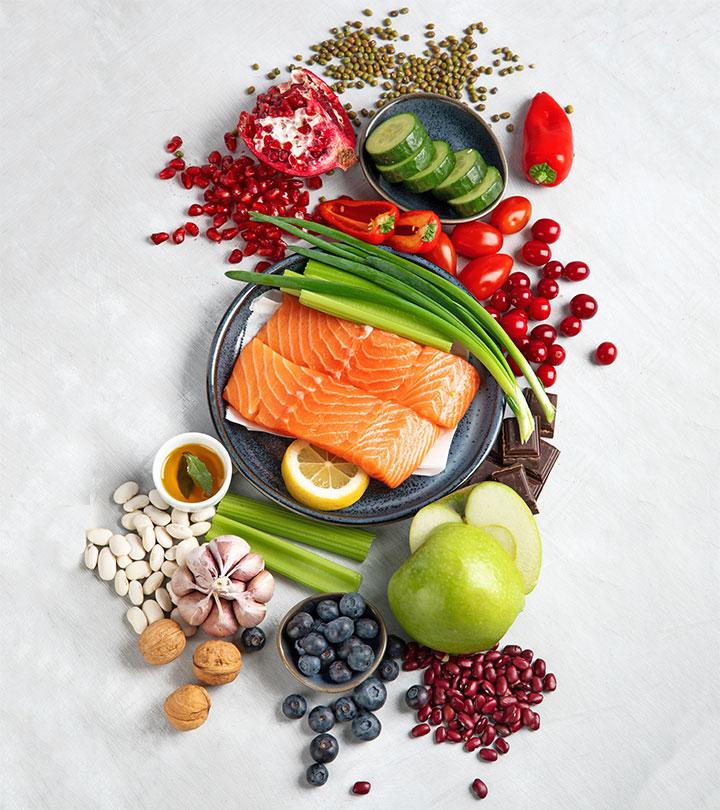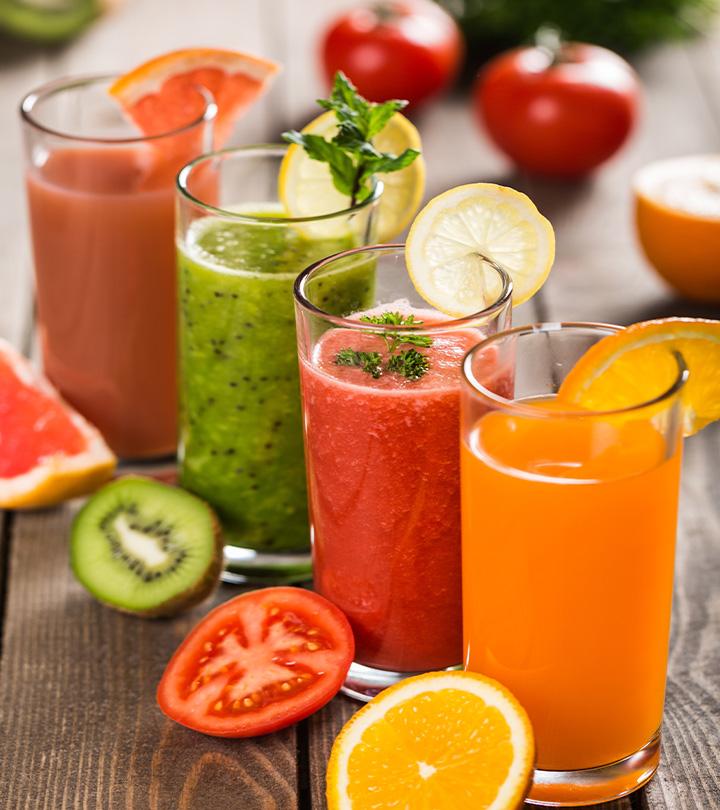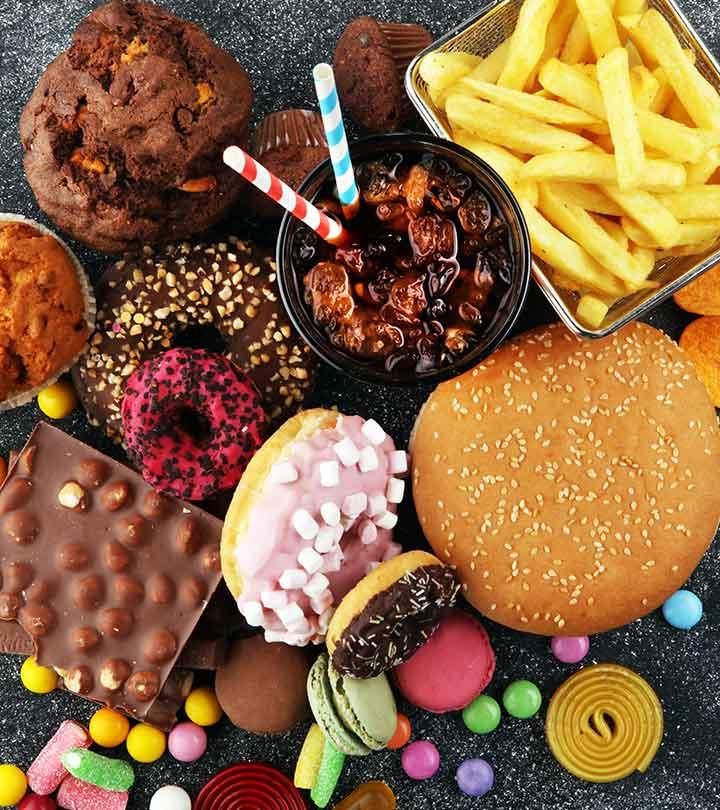High-Protein Diet: Benefits, How It Works, & What You Can Eat
Nourish your body with protein-packed foods to stay fit, inside and out.

Image: Shutterstock
When it comes to healthy diets, a high-protein diet is often recommended by fitness enthusiasts and trainers. It serves as a dynamic and transformative approach to fueling your body. This dietary strategy revolves around increasing your daily protein intake by adding protein-rich foods like lean meats, fish, dairy, legumes, and nuts to your meals. This widely adopted nutritional regimen has garnered attention as it offers benefits for both your health and physique. In this article, we unravel the science behind the high-protein diet and understand the advantages it offers. Keep reading to learn more!
 At A Glance: High-Protein Diet
At A Glance: High-Protein Diet- Principle: Increased daily protein intake to lose weight or sculpt the body.
- Purpose: To boost muscle development, enhance satiety, aid weight management, and boost metabolic function.
- Who Is It For: Individuals seeking improved physical performance, muscle gain, and weight loss, as well as athletes, fitness enthusiasts, and those aiming to maintain lean muscle mass.
- Duration: Can be short-term or long-term, depending on individual fitness goals.
- Who Should Avoid: People with kidney issues or other medical conditions that require restricted protein intake.
- Cons: Excessive protein intake may strain the kidneys, cause digestive discomfort like flatulence or bloating, and may not be suitable for those with specific health conditions. It may also lead to an increased intake of saturated fats or increased blood pressure levels if not carefully managed.
In This Article
What Is Protein And Why Is It Important?
Protein is a fundamental nutrient that plays a pivotal role in your overall health. It is composed of small units called amino acids and can be likened to building blocks that make up your body. Your body creates several different proteins, with different pairings and combinations of amino acids, that serve as the foundation for your muscles, tissues, and organs (1).
 Did You Know?
Did You Know?Protein is your body’s go-to component for building and repairing muscles. When you engage in physical activities or even just daily movements, your muscles experience tiny tears. Protein swoops in to mend these tears, making your muscles stronger and more resilient in the process (2).
It is also vital for cell growth and maintenance. Your body is a bustling factory of cell production and replacement. Whether you are growing, recovering from an injury, or just keeping things ticking along smoothly – protein ensures you have the necessary raw materials to keep your body functioning properly (3).
Thus, protein is essential for muscle strength and cell growth, making it a cornerstone of your overall health. This macronutrient is also the center of attention for different nutritional strategies to reap these benefits. Learn about one of the key protein-based diets in the next section.
What Is A High-Protein Diet?

A high-protein diet places a strong emphasis on increasing your daily intake of protein-rich foods. Unlike some diets that restrict certain food groups, a high-protein diet encourages you to consume more protein while maintaining a balanced diet overall (4).
The ratio of protein intake in this diet can vary depending on individual needs, goals, and the specific diet plan being followed. However, a common guideline for this diet is to aim for protein to make up about 20% to 35% of your total daily caloric intake or 0.8-1 gm per kg body weight (5).
Note: If you are considering a high-protein diet, it is advisable to consult with a healthcare provider, registered dietitian, or nutritionist. They can provide personalized recommendations tailored to your unique needs, ensuring that your dietary choices align with your health goals.
A high-protein diet can have a profound impact on your health, weight, and overall well-being. But how does it work? Keep reading to learn more about the science behind it.
How Does A High-Protein Diet Work?
Increasing your intake of protein leads to a surplus of amino acids in the body. This plays a vital role in mending tissues, including muscles, and promoting their growth and strength (6).
Moreover, protein-rich foods take longer to digest and help stabilize blood sugar levels, thus reducing the urge to snack between meals as it keeps you fuller for a longer time. The feeling of fullness may lead to decreased calorie intake, making it an effective tool for weight management (7).
Also, high-protein diets may sometimes lead to a mild form of ketosis. This is particularly observed when carbohydrate intake is restricted (7). Ketosis is a metabolic state that occurs when you significantly reduce your carbohydrate intake and replace it with higher fat and moderate protein consumption. In this state, the body starts breaking down fats into molecules called ketones. Ketones can be used as an alternative source of energy to maintain the body’s functioning (8). Mild ketosis can enhance the fat breakdown and utilization of energy. This further contributes to weight loss (9).
A high-protein diet offers several other benefits as well. Keep scrolling through to uncover them.
Benefits Of A High-Protein Diet
- May Help Build And Maintain Muscles
Exercising can take a toll on your muscles. Protein is essential for building and repairing muscles. If you are engaged in regular physical activity or strength training, a high-protein diet provides the amino acids needed to support muscle growth and recovery (10).
- May Boost Muscle Recovery
After an intense workout, the body requires adequate protein to repair and recover itself. A high-protein diet may aid faster recovery, reducing muscle soreness and allowing you to stay active (11).
- May Aid Weight Management
High-protein diets are known for their ability to promote satiety and reduce hunger, aiding weight loss or management (7). When you consume protein, it triggers the release of hormones like cholecystokinin (CCK) and peptide YY (PYY). These hormones tell your brain that you are full. When you feel full, you are less likely to overeat or snack on unhealthy foods that contribute to weight gain.
Additionally, protein slows down the emptying of the stomach, leading to a prolonged feeling of fullness (12).
Also, high-protein diets can promote fat loss while preserving lean muscle mass (13). This means you are more likely to lose fat instead of valuable muscle tissue while trying to lose weight.
- May Boost Metabolism
Protein requires more energy to digest compared to fats and carbohydrates. This thermogenic effect may increase calorie expenditure and enhance metabolism, thus aiding weight control (14). However, further research studies or large-scale clinical trials are necessary to support this claim.
- May Help Control Blood Sugar
Protein-rich meals may help stabilize blood sugar levels by preventing rapid spikes and crashes. This is particularly beneficial for individuals with diabetes or at risk of developing the condition (15).
- May Promote Bone Health
Some high-protein foods, like dairy products and lean meats, are also rich in essential nutrients like calcium and phosphorus that contribute to improved bone health (16), (17).
- May Promote Fitness In Older Adults
Muscle mass and function tend to decline with age. However, a high-protein diet may help mitigate this loss by providing the necessary amino acids for muscle synthesis and repair (18).
- May Lower Your Blood Pressure
The ACE enzyme (angiotensin-converting enzyme) converts a compound known as angiotensin I into angiotensin II, a potent vasoconstrictor. This conversion raises blood pressure by narrowing the blood vessels and promoting the retention of sodium and water in the body. Plant-based protein sources like legumes contain bioactive peptides known as ACE inhibitors, which have been found to help lower blood pressure by inhibiting the ACE enzyme (19). However, some experts have also observed an increase in blood pressure in certain individuals who have adopted a high-protein diet. Therefore, further research is required to support this claim.
- May Boost Cognitive Health
The amino acids from dietary proteins are precursors to neurotransmitters like serotonin and dopamine. These compounds play an important role in mood regulation. Protein intake may influence the synthesis of these neurotransmitters, potentially improving your mood and cognitive function (20).
While high-protein diets do offer numerous benefits, balance is key. It is necessary to not overindulge in protein and only consume it as needed. Learn more about its recommended daily intake in the next section.
How Much Protein Should You Eat Every Day?
Determining your daily protein intake depends on several factors, including your age, gender, activity level, and health goals.
However, as a general guideline, the recommended dietary allowance for protein is approximately 0.8 grams of protein per kilogram of body weight for adults (4). This means that a sedentary adult weighing 70 kilograms (154 pounds) would require about 56 grams of protein daily.
For those with higher activity levels or specific fitness goals, such as building muscle, the protein needs may be greater. Athletes or individuals engaged in regular strength training may aim for a range of 1.2 to 2.2 grams of protein per kilogram of body weight (6).
In a high-protein diet, the specific amount of protein intake can vary, but a common guideline is for protein to make up about 20% to 35% of your total daily caloric intake (5).
For example, if you consume 2,000 calories per day, a high-protein diet within this range would include approximately 100 to 175 grams of protein daily. However, this is just a rough estimate, and the ideal amount depends on individual factors such as your age, gender, activity level, and health goals.
It is recommended to consult a registered dietitian or nutritionist for personalized guidance.
Both the high-protein diet and the keto diet follow the principle of ketosis for weight loss. So, which diet should you follow for maximum benefits? Keep reading as we compare both diets to help you choose the best one for you.
High-Protein Diet Vs. Ketogenic Diet
The key difference between a high-protein diet and a ketogenic diet lies in their macronutrient composition.
A high-protein diet focuses on increased protein intake while maintaining a balance of carbohydrates and fats. It is suitable for those aiming to build muscle, manage weight, or enhance overall health (5), (6), (7). In contrast, a ketogenic diet is high in healthy fats and extremely low in carbohydrates, designed to induce and maintain ketosis. This primarily aids rapid fat loss and supports blood sugar control (21).
High-protein diets are versatile and work well for a broad audience, while ketogenic diets are specialized and best suited for those with specific health needs like weight loss or blood sugar regulation.
Nevertheless, choosing to follow either diet requires careful consideration of individual goals and health status. Always have a certified nutritionist check if a diet suits you after carefully evaluating your health history.
Adopting a high-protein diet goes beyond calculating your protein requirements and visualizing your fitness goals. Keeping a few pointers in mind can help you follow it successfully. Discover them in the next section.
How To Follow A High-Protein Diet
- Calculate Your Protein Intake
Start by calculating your daily protein requirements based on factors like age, gender, activity level, and specific goals. As a general guideline, aim for protein to make up about 20% to 35% of your daily caloric intake.
- Organize Your Grocery List
Opt for lean and high-quality protein sources to ensure you are getting the best nutrition. Great options include poultry, fish, lean meats (like chicken and turkey), eggs, low-fat dairy, tofu, legumes (such as beans and lentils), and nuts.
 Pro Tip
Pro Tip- Plan Your Meals Ahead
Design your meals with a balance of protein, carbohydrates, and healthy fats. Incorporate whole grains, fruits, vegetables, and sources of healthy fats like avocados, olive oil, and nuts to create well-rounded, nutritious meals.
It is also recommended to distribute your protein intake evenly throughout the day. Including protein-rich foods in each meal can help maintain stable energy levels and promote muscle recovery. You should also plan healthy snacks to keep you energized throughout the day and prevent unhealthy snacking.
- Practice Portion Control
Pay attention to portion sizes as overeating, even with healthy foods, may lead to excessive calorie intake. You can consult with a registered dietitian if you are unsure about the appropriate portion sizes for your goals.
- Avoid Excessive Protein Supplementation
While protein supplements can be useful, it is generally best to get most of your protein from whole foods. Supplements should complement your diet, not replace it.
 Pro Tip
Pro TipIt is also necessary to keep track of your progress and how your body responds to the diet. You can keep a journal to track your progress and food intake or use a fitness or health app.
Remember that individual protein needs can vary, so ensure your high-protein diet is tailored to your specific requirements. You can adjust your protein intake with the best natural sources. Scroll below to learn more about them.
What Are The Best High-Protein Foods?
Here is a list of some of the best high-protein foods you can include in your meals:
1. Chicken Breast
Skinless, boneless chicken breast is a lean source of protein, providing around 23.2 g of protein per 100 g serving (22). It is versatile and can be prepared in various ways.
2. Turkey
Turkey is a lean poultry option rich in protein, offering about 18.7 g per 100 g serving (23). It is a great choice for sandwiches, salads, or as a main dish.
3. Eggs
Eggs are a nutrient powerhouse, with around 6.3 g of protein per large egg (24). They can be used in countless recipes, from omelets to baked goods.
4. Greek Yogurt

Greek yogurt is packed with protein, offering approximately 10.3 g per 100 g serving (25). It is a creamy and satisfying snack or breakfast option. You can also have it as a healthy dessert option when paired with honey, fruits, nuts, and oats.
5. Cottage Cheese
Cottage cheese is rich in protein, providing about 8.3 g per 100 g serving (26). It can be enjoyed on its own or added to salads and recipes.
6. Salmon
Salmon is not only a great source of protein (around 20.4 g per 100 g serving), but it also provides heart-healthy omega-3 fatty acids (27), (28).
7. Tofu
Tofu is a plant-based protein option, offering roughly 7 g per 100 g serving. It is a popular ingredient in vegetarian and vegan dishes (29).
8. Lentils
Lentils are legumes that provide about 9 g of protein per half-cup serving when cooked (30). They are also high in fiber, making them a fantastic addition to soups and stews (31).
9. Quinoa
Quinoa is a complete protein source, offering approximately 8.14 g of protein per cup when cooked (32). It is an excellent choice for grain-based salads and side dishes.
10. Lean Beef
Lean cuts of beef, like sirloin or tenderloin, provide approximately 22.2 g of protein per 100 g serving (33).
11. Peanuts
Peanuts are a protein-packed nut, supplying approximately 25.8 g of protein per 100 g serving (34).
12. Edamame
Edamame are young soybeans that contain around 11.5 g of protein per 100 g serving (cooked) (35).
13. Chickpeas
Chickpeas, also known as garbanzo beans, are another protein-rich legume, offering about 8.8 g of protein per 100 g serving (cooked) (36).
14. Pork Tenderloin
Pork tenderloin is a lean cut of pork, providing roughly 20.6 g of protein per 100 g serving (37).
15. Beans
Beans are excellent sources of plant-based protein. For example, black beans contain approximately 8.8 g of protein per 100 g serving (cooked) (38).
Other than these natural ingredients, you can also fulfill your protein requirements with supplements and powders. Keep scrolling to learn more about them.
What About Protein Powders?
Protein powders serve as a valuable ally for those who are planning to follow a high-protein diet. These convenient supplements offer a quick and efficient way to elevate your protein intake.
They cater to the needs of athletes, fitness enthusiasts, and anyone striving to maintain or build muscle. Protein powders are particularly beneficial for post-workout recovery, as they swiftly provide the essential amino acids crucial for muscle repair (39).
A well-chosen protein powder can be a practical solution for those who are unable to meet their daily protein goals. However, consult with your nutritionist to determine which protein powder will suit your needs, the correct portion size, and when to have it. However, it is vital to remember that protein powder should complement a balanced diet rich in whole food sources of protein, not replace them.
You can follow a balanced diet on this nutritional regimen easily. If you need help planning your meals, explore the unique and nutritious dishes shared in our meal plan below. They are all portioned to align with the principles of the high-protein diet.
7-Day High-Protein Meal Plan For Weight Loss
| Day 1 |
|---|
| Meal | What To Eat |
|---|---|
| Breakfast | Cottage cheese pancakes (3 small) with mixed berries (1/2 cup) |
| Lunch | Chicken and quinoa-stuffed bell peppers (1 pepper) with a side of steamed asparagus (1 cup) |
| Snack | Hummus (2 tbsp) with carrot sticks (1 cup) |
| Dinner | Grilled tofu (4 oz) with sautéed spinach (1 cup) and a quinoa salad (1/2 cup) |
| Day 2 |
|---|
| Meal | What To Eat |
|---|---|
| Breakfast | Overnight oats with rolled oats (1/2 cup), chia seeds (1 tbsp), almond milk (1 cup), and sliced almonds (1 tbsp) |
| Lunch | Chicken and vegetable stir-fry with chicken strips (4 oz), mixed vegetables, and teriyaki sauce |
| Snack | Cottage cheese (1/2 cup) with sliced peaches (1/2 cup) |
| Dinner | Baked tilapia (4 oz) with brown rice (1/2 cup) and steamed broccoli (1 cup) |
| Day 3 |
|---|
| Meal | What To Eat |
|---|---|
| Breakfast | Omelet with egg whites (3), spinach, mushrooms, and feta cheese (1 oz) |
| Lunch | Lentil soup (1 cup) with a side salad (mixed greens, cucumber, and red onion) |
| Snack | Almonds (1/4 cup) |
| Dinner | Baked chicken breast (4 oz) with quinoa (1/2 cup) and steamed green beans (1 cup) |
| Day 4 |
|---|
| Meal | What To Eat |
|---|---|
| Breakfast | Greek yogurt parfait with Greek yogurt (6 oz), strawberries (1/2 cup), and granola (2 tbsp) |
| Lunch | Tuna salad (canned tuna, mixed greens, cherry tomatoes, cucumber) (1 bowl) with olive oil and lemon dressing |
| Snack | Celery sticks (1 cup) with peanut butter (2 tbsp) |
| Dinner | Baked cod (4 oz) with cauliflower mash (1 cup) and roasted carrots (1 cup) |
| Day 5 |
|---|
| Meal | What To Eat |
|---|---|
| Breakfast | Breakfast burrito with scrambled eggs (2), black beans (1/2 cup), salsa, and whole-wheat tortilla |
| Lunch | Grilled vegetable and chickpea salad with feta cheese (1 oz) and balsamic vinaigrette |
| Snack | Edamame (1 cup) |
| Dinner | Beef stir-fry (4 oz) with brown rice (1/2 cup) and stir-fried bell peppers and broccoli (1 cup) |
| Day 6 |
|---|
| Meal | What To Eat |
|---|---|
| Breakfast | Scrambled tofu (1 cup) with spinach (1/2 cup) and cherry tomatoes (1/2 cup) |
| Lunch | Grilled chicken salad with mixed greens and avocado (1/4) |
| Snack | Greek yogurt (6 oz) with blueberries (1/2 cup) and a drizzle of honey |
| Dinner | Baked salmon (4 oz) with quinoa (1/2 cup) and roasted asparagus (1 cup) |
| Day 7 |
|---|
| Meal | What To Eat |
|---|---|
| Breakfast | Smoothie with spinach, banana, protein powder, and almond milk (1 cup) |
| Lunch | Turkey and avocado wrap with whole-wheat tortilla, turkey slices (3 oz), avocado (1/4), lettuce, and tomato |
| Snack | Cottage cheese (1/2 cup) with pineapple chunks (1/2 cup) |
| Dinner | Grilled shrimp (4 oz) with brown rice (1/2 cup) and sautéed broccoli (1 cup) |
The above meal plan contains a wide variety of protein sources, including animal and plant-based ones. Nevertheless, if you are unable to include animal protein in your meals due to dietary restrictions, you can still follow this diet successfully.
With careful planning and smart food choices, individuals following a plant-based diet can meet their protein needs while enjoying a variety of delicious and nutritious meals. Learn how you can do so in the next section.
High-Protein Diet For Vegetarians And Vegans
Vegetarians and vegans can also enjoy the benefits of a high-protein diet, contrary to the misconception that high-protein diets are exclusively for meat-eaters. All you need to do is consume the following popular plant-based protein sources:
1. Legumes
Legumes are the plant kingdom’s protein powerhouse. Foods like lentils, chickpeas, black beans, and peas are rich in protein. You can use them in salads, soups, and main dishes. For instance, hummus made from chickpeas is a tasty protein-rich dip.
2. Tofu And Tempeh
Tofu and tempeh are soy-based products that offer substantial protein content. Tofu can be grilled, stir-fried, or blended into smoothies, while tempeh can be used in sandwiches, stir-fries, or crumbled as a meat substitute.
3. Nuts And Seeds
Almonds, peanuts, chia seeds, and hemp seeds are excellent sources of protein and healthy fats. They can be sprinkled on salads, and oatmeal, or enjoyed as snacks.
4. Whole Grains
Whole grains like quinoa, farro, and bulgur are said to contain more protein compared to refined grains. They make hearty and protein-rich bases for salads and grain bowls.
5. Dairy Alternatives
If you are a lacto-vegetarian, dairy products like Greek yogurt and cottage cheese can be valuable sources of protein. Vegans can opt for fortified dairy alternatives like almond milk or soy yogurt.
6. Seitan
Seitan, also known as wheat gluten, is a meat substitute that is extremely high in protein. It can be used in stir-fries, sandwiches, or as a pizza topping.
Aside from these suggestions, if you still find it challenging to meet your protein goals through whole foods alone, consider plant-based protein supplements like pea protein or rice protein powders. You can also talk to a registered dietitian who specializes in vegetarian or vegan nutrition.
These food sources are packed with protein. However, if you do not calculate your protein intake needs correctly, you are at risk of excess protein supplementation. This condition comes with its own set of potential adverse effects. Learn more about them below.
Side Effects Of A High-Protein Diet
You may experience the following side effects after following a high-protein diet:
- Nutritional Deficit
Overdoing the high-protein diet can sometimes backfire. It may lead to nutritional deficiencies, leaving you short on vital nutrients like fiber, vitamins, and minerals.
- Digestive Discomfort
Excessive protein intake may lead to digestive issues like constipation or diarrhea in some individuals (40).
- Kidney Strain
Extremely high-protein diets may put added stress on the kidneys, potentially causing problems for those with pre-existing kidney conditions (41).
- Ketosis Symptoms
In certain cases, a high-protein diet may induce ketosis, resulting in side effects like bad breath and fatigue (42).
Thus, it is crucial to strike a balance by including a variety of foods in your diet. This ensures that you get not only ample protein but also a spectrum of essential nutrients.
Infographic: Top Benefits Of A High-Protein Diet
A high-protein diet can help bring you closer to your health and fitness goals. Just by increasing your intake of dietary protein, you can reap several health advantages, from enhancing muscle strength to promoting weight management. Check out the following infographic to learn more about the health benefits of adopting a high-protein diet.

Illustration: StyleCraze Design Team
The high-protein diet is a versatile and effective dietary approach with numerous benefits for those seeking to improve their health and fitness. Its emphasis on lean protein sources supports muscle strength and weight management. However, it is vital to eat balanced meals, as excessive protein intake can lead to potential side effects like nutritional deficiencies and stomach discomfort. The key lies in moderation and a well-rounded diet that includes a variety of nutrients. Whether your goal is building muscle, shedding pounds, or simply maintaining your overall health, a high-protein diet can be a valuable tool when approached with mindfulness and a commitment to dietary diversity.
Frequently Asked Questions
When should you avoid protein shakes?
Avoid protein shakes if they do not align with your dietary goals or if you can meet your protein needs through whole foods. If you have specific health conditions, consult a healthcare provider before consuming protein shakes.
Is a higher protein intake right for me?
A higher protein intake is suitable for many, especially those aiming for muscle growth, weight management, or enhanced satiety. However, individual needs vary, so consult a dietitian to determine the right protein level for you.
Does excess protein turn into sugar?
Excess protein does not directly convert to sugar, but it can be converted to glucose in a process called gluconeogenesis when needed for energy (33).
Will eating more protein kick me out of ketosis?
Eating more protein alone is unlikely to kick you out of ketosis. Focus on keeping carbohydrate intake very low while moderating protein and emphasizing healthy fats to maintain ketosis.
Is a higher protein diet more expensive?
A high-protein diet can be more expensive if it relies heavily on animal sources. However, budget-friendly options like beans, lentils, and eggs make it feasible to achieve a high-protein diet without breaking the bank.
Key Takeaways
- Protein is a fundamental nutrient that serves as the building blocks for our muscles, tissues, and organs.
- A high-protein diet involves increasing your daily protein intake with foods like lean meats, fish, dairy, legumes, and nuts.
- It can lead to muscle growth, stabilize blood sugar levels, and potentially induce mild ketosis, which aids in fat loss.
- However, excessive protein intake can have side effects, including kidney strain and digestive discomfort.

Image: Dall·E/StyleCraze Design Team
Watch the following informative video to dive into the fascinating world of high-protein foods. From lean meats to plant-based powerhouses, discover the top protein-packed options for a healthy lifestyle.
References
Articles on StyleCraze are backed by verified information from peer-reviewed and academic research papers, reputed organizations, research institutions, and medical associations to ensure accuracy and relevance. Read our editorial policy to learn more.
- Protein and Amino Acids
https://www.ncbi.nlm.nih.gov/books/NBK234922/ - Nutrition and Muscle Recovery
https://www.ncbi.nlm.nih.gov/pmc/articles/PMC7909540/ - Physiology, Proteins
https://www.ncbi.nlm.nih.gov/books/NBK555990/ - Increased Dietary Protein as a Dietary Strategy to Prevent and/or Treat Obesity
https://www.ncbi.nlm.nih.gov/pmc/articles/PMC6179508/ - Protein-Rich Diets for Weight Loss Maintenance
https://pubmed.ncbi.nlm.nih.gov/32542589/ - Recent Perspectives Regarding the Role of Dietary Protein for the Promotion of Muscle Hypertrophy with Resistance Exercise Training
https://www.ncbi.nlm.nih.gov/pmc/articles/PMC5852756/ - A high-protein diet for reducing body fat: mechanisms and possible caveats
https://www.ncbi.nlm.nih.gov/pmc/articles/PMC4258944/ - Ketosis, ketogenic diet and food intake control: a complex relationship
https://www.ncbi.nlm.nih.gov/pmc/articles/PMC4313585/ - Nutritional Ketosis for Weight Management and Reversal of Metabolic Syndrome
https://www.ncbi.nlm.nih.gov/pmc/articles/PMC6472268/ - Protein Intake and Exercise-Induced Skeletal Muscle Hypertrophy: An Update
https://www.ncbi.nlm.nih.gov/pmc/articles/PMC7400877/ - The impact of dietary protein supplementation on recovery from resistance exercise-induced muscle damage: A systematic review with meta-analysis
https://www.ncbi.nlm.nih.gov/pmc/articles/PMC10393778/ - The Satiating Effect of Dietary Protein Is Unrelated to Postprandial Ghrelin Secretion
https://academic.oup.com/jcem/article/90/9/5205/2838688?login=false - Clinical Evidence and Mechanisms of High-Protein Diet-Induced Weight Loss
https://www.ncbi.nlm.nih.gov/pmc/articles/PMC7539343/ - Postprandial thermogenesis is increased 100% on a high-protein, low-fat diet versus a high-carbohydrate, low-fat diet in healthy, young women
https://pubmed.ncbi.nlm.nih.gov/11838888/ - High-Protein Diets for Treatment of Type 2 Diabetes Mellitus: A Systematic Review
https://www.ncbi.nlm.nih.gov/pmc/articles/PMC6628842/ - Dairy products and bone health
https://www.ncbi.nlm.nih.gov/pmc/articles/PMC8794967/ - Dietary protein is beneficial to bone health under conditions of adequate calcium intake: an update on clinical research
https://www.ncbi.nlm.nih.gov/pmc/articles/PMC4180248/ - Protein, weight management, and satiety
https://www.sciencedirect.com/science/article/pii/S0002916523236643?via%3Dihub - Effect of soybean protein on blood pressure: a randomized, controlled trial
https://pubmed.ncbi.nlm.nih.gov/15998749/ - Large neutral amino acids: dietary effects on brain neurochemistry and function
https://link.springer.com/article/10.1007/s00726-012-1330-y - Advantages and Disadvantages of the Ketogenic Diet: A Review Article
https://www.ncbi.nlm.nih.gov/pmc/articles/PMC7480775/ - Boneless skinless chicken breasts
https://fdc.nal.usda.gov/fdc-app.html#/food-details/577591/nutrients - Turkey, ground, 93% lean, 7% fat, raw
https://fdc.nal.usda.gov/fdc-app.html#/food-details/172850/nutrients - Egg, whole, raw, fresh
https://fdc.nal.usda.gov/fdc-app.html#/food-details/171287/nutrients - Yogurt, Greek, plain, nonfat
https://fdc.nal.usda.gov/fdc-app.html#/food-details/330137/nutrients - Cottage cheese
https://fdc.nal.usda.gov/fdc-app.html#/food-details/560705/nutrients - Fish, salmon, Atlantic, farmed, raw
https://fdc.nal.usda.gov/fdc-app.html#/food-details/175167/nutrients - Marine Omega-3 (N-3) Fatty Acids for Cardiovascular Health: An Update for 2020
https://www.ncbi.nlm.nih.gov/pmc/articles/PMC7072971/ - Tofu
https://fdc.nal.usda.gov/fdc-app.html#/food-details/1741391/nutrients - Lentils, mature seeds, cooked, boiled, without salt
https://fdc.nal.usda.gov/fdc-app.html#/food-details/172421/nutrients - Proximate Analysis and Nutritional Evaluation of Twenty Canadian Lentils by Principal Component and Cluster Analyses
https://www.ncbi.nlm.nih.gov/pmc/articles/PMC7073932/ - Quinoa, cooked
https://fdc.nal.usda.gov/fdc-app.html#/food-details/168917/nutrients - Beef, tenderloin, steak, separable lean only, trimmed to 1/8″ fat, choice, raw
https://fdc.nal.usda.gov/fdc-app.html#/food-details/174762/nutrients - Peanuts, all types, raw
https://fdc.nal.usda.gov/fdc-app.html#/food-details/172430/nutrients - Edamame, cooked
https://fdc.nal.usda.gov/fdc-app.html#/food-details/1100450/nutrients - Chickpeas (garbanzo beans, bengal gram), mature seeds, cooked, boiled, without salt
https://fdc.nal.usda.gov/fdc-app.html#/food-details/173757/nutrients - Pork, fresh, loin, tenderloin, separable lean and fat, raw
https://fdc.nal.usda.gov/fdc-app.html#/food-details/168312/nutrients - Beans, black, mature seeds, cooked, boiled, without salt
https://fdc.nal.usda.gov/fdc-app.html#/food-details/173735/nutrients - Effects of Protein Supplementation on Performance and Recovery in Resistance and Endurance Training
https://www.ncbi.nlm.nih.gov/pmc/articles/PMC6142015/ - A Review of Issues of Dietary Protein Intake in Humans
https://journals.humankinetics.com/view/journals/ijsnem/16/2/article-p129.xml - The Effects of High-Protein Diets on Kidney Health and Longevity
https://www.ncbi.nlm.nih.gov/pmc/articles/PMC7460905/ - Ketogenic diets: Boon or bane?
https://www.ncbi.nlm.nih.gov/pmc/articles/PMC6251269/ - Physiology, Gluconeogenesis
https://www.ncbi.nlm.nih.gov/books/NBK541119/













